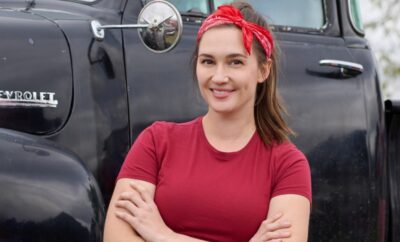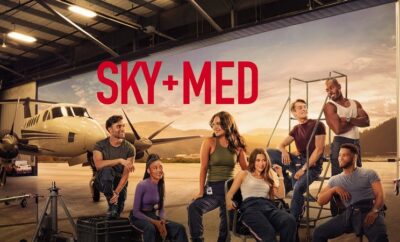Features
The Importance of Queer YouTube Reactors
By: Kathryn Trammell
Back before the Internet attempted to connect us all and television shows attempted to offer us inclusive programming through “diverse” storylines, queer people turned to bars and other meeting places inside big cities to find culture, mentorship and a community they felt they could safely belong to. After these places closed, the role of mentorship was displaced and began to fall on TV characters who were, in some cases, the first queer “people” to whom real queer and questioning people had ever been exposed. Naturally, this representation held power and significance in its rarity, which is why when storytellers decide to erase from their shows the single queer character on the single TV show that airs on that one single, special night of the week, it hurts. The death of this character, who finally represented a part of you that couldn’t be shared with those around you, would create a hole inside you – a missing piece of your identity. For those struggling with these exact feelings during 2016’s resurgence of the “Dead Lesbian Syndrome” trope on TV, a group of people helped ease what was missing from the queer community in the wake of so many deaths by offering a new kind of guidance and mentorship. They are queer YouTube reactors, whose rise in popularity and prevalence during 2016 was due largely to a community’s need for a form of representation more steadfast than that which could be felled by a stray bullet.
To an outsider, the purpose of a YouTube reactor might seem strange – why would someone want to watch someone else watching and reacting to a TV show? But to their thousands of subscribers, the majority of which make up the niche audiences who are overwhelmingly underrepresented in entertainment, queer YouTube reactors offer something very different to the queer community than fictional characters on TV do and that is the power of interpersonal communication.
To better understand the role this communication is playing in our community and to discuss the subculture created from it, I reached out to five YouTube reactors for their input on the matter. So, before continuing on, allow me to introduce to you the ladies who helped author and inspire this piece:
Honestlynatalie: Hales from Norway; has reacted to web series Carmilla and Couple-ish as well as TV shows “The 100,” “Wynonna Earp” and currently “Supergirl;” known for saying either “Oh my God!” or “Herregud!” depending on how stressful a scene is to watch, tossing items into the air in celebration of happy scenes and Pillow Clutching™. Watch her YouTube channel.
Rin: Hales from Australia; has reacted to “The 100,” “Person of Interest,” “Games of Thrones” (which she plans to continue into Season Seven) and currently reacts to “Supergirl;” known for repeating the words “Oh no” in rapid succession when she anticipates something bad will happen, the “Lexa Deserved Better” Project, home-brewed beer and Flailing Arms of Excitement™. Watch her YouTube channel.
Sofia Rojas: Hales from Canada; has reacted to “The 100,” “Fear the Walking Dead” (which she plans to continue into Season Three) and currently reacts to “Supergirl” with plans to react to “Wynonna Earp” Season Two; known for saying “you guys” the way friends say it to friends, tapping her lips (sometimes with her Lexa gear around her neck) when she becomes thoughtful and The Hair SideSweep™. Watch her YouTube channel.
Elke: Hales from The Netherlands; has reacted to “The 100,” “Fear the Walking Dead,” “Wynonna Earp” and currently “Supergirl;” known for fantastically sarcastic commentary, bursting out into song when something she sees or hears reminds her of a single song lyric and F**kbuckets™. Watch her YouTube channel.
Marcie Defeo: Hales from America; reacts to “Wynonna Earp,” “The 100,” “Supergirl,” “The Magicians,” “Dark Matter,” “Killjoys” and “American Horror Story;” known for calling actors by the character name with which she most associates them regardless of the role she is currently watching them portray, talking to herself as much as she talks to her camera/viewers and an array of beanies might be her trademark. Watch her YouTube channel.
Separately, each YouTuber has a different style of providing commentary, emotionally reacts to scenes in different ways and even has different interests in the shows they watch. But together they share in common the ability to provide their audience a sense of companionship that can’t be duplicated through a fictional TV storyline or through faceless forms of social media. For those who know no other queer people like themselves in their school, workplace or neighborhood, the power of being able to see someone share the feelings that make them fundamentally unique can be a very comforting experience. And it’s what initially drove many current YouTube reactors like Honestlynatalie to watch reaction videos prior to making her own. “Back when I was a teen,” she said, “’Buffy the Vampire Slayer’ was basically my religion and nobody else shared that passion with me. It was incredibly lonely. You have no idea how much I wished someone would just get it. So, when I discovered Mark [Oshiro’s videos] it felt amazing to get to watch someone who was also gay and actually cared.”
The sense of companionship created by seeing someone who feels the way you do is also powerful in that it is extremely self-affirming. A queer or questioning individual raised in a heteronormative society might believe their feelings to be completely invalid until they are exposed to other queer people who are self-aware and who express that awareness openly and proudly. This is what YouTube reactors are able to provide their viewers – open and self-aware affirmation, which is exactly why Sofia Rojas initially sought out YouTube reaction videos. “I was drawn more specifically towards The Legend of Korra reaction videos,” she said, “because I wanted to see if people saw what I was seeing between Korra and Asami . . . I was not big into Twitter or Tumblr at the time, so the reaction videos were the only way I could confirm that what I was seeing was actually being seen by others.” Having this affirmation and, in turn, being able to provide it to others is a cornerstone of building relationships and it is no doubt why so many people feel like YouTube reactors provide them with a community of companionship and support.
As I mentioned earlier, the queer community used to have a much more physical presence during times when the Internet did not connect us together. Queer people would use those spaces to essentially observe queerness – to learn form each other, to understand and prepare for our own experiences through hearing about the experiences of the mentors around us and to feel supported when the world around you feels so new. Because when you come out to yourself, the world does feel brand new and we have to learn how to live inside it. For queer women; however, those spaces for observing our own community have largely disappeared from both cities and from TV. That is why opportunities for observing queerness provided by young, queer woman on YouTube have become so essential and so important.
When you watch a queer person reacting to a show featuring a queer storyline, which is oftentimes defined by a relationship, you are literally watching someone openly express the emotions and feelings that have allowed that individual to identify as queer. From Lexa’s (Alycia Debnam Carey) death to Alex Danvers (Chyler Leigh) coming out, queer YouTube reactors validate the experiences of a community they authentically represent and in doing so they provide companionship where some individuals might have none. “The most common thing people will say about watching a reaction,” Rin said, “is that it feels like they are watching with a friend . . . that’s the kind of beauty of reaction videos, and it’s exactly the type of feeling I want to invoke.” The fact that this companionship and representation is offered by women who identify as queer or lesbian makes the content that these YouTubers produce even more profound. “[Queer women] have so few characters on TV to champion,” Rin continued, “that it does seem more important to have actual queer people making content about the queer characters we love. I think it’s along the same lines as representation in the media. You’re going to relate more to someone who is more like you, than someone who is not.”
This sense of companionship and need for authentic representation is especially necessary when representation is erased from other forms of media, like it was when Lexa was killed off of “The 100.” Many of the YouTubers I interviewed said that it was at this point they realized the importance of the representation they were providing to the queer community. “A lot of people were lost,” said Rin, “and it felt like they were looking towards ‘prominent’ figures in fandom for answers. Seeing my reaction, seeing me scream and break down in tears, I think it was a comfort for people to see it. To know that they weren’t all alone in their grief.” By providing representation that is authentic in both emotionality and in its expression of queerness, queer YouTube reactors were and are able to “create a feeling of togetherness that we might not find elsewhere,” Elke said. “It’s a way for us to realize that we are not alone and that we can proudly be ourselves.”
Unfortunately, it’s the aspect of “being yourself” that is often called into question by YouTube subscribers who doubt the authenticity of reaction videos. Specifically, they question if whether the reactions themselves are genuine or performed. But the only “performing” that occurs in most YouTube reaction videos is the performance of allowing oneself to show on the outside what they typically reserve on the inside, something Honestlynatalie claims is a conscious effort. “Instead of just feeling [my emotions] on the inside, I choose to let them out . . . the feelings and thoughts are real. It’s not something I choose to feel, it’s something I choose to show.” Besides, “if a person is putting on a performance,” Elke added, “the whole purpose of sharing subjective reactions is lost. I would say everyone doing reaction videos is being their authentic self, sometimes more than they would be in person,” which many YouTubers reasoned is directly due to the very trusting relationship they develop with their audience. “Knowing my viewers want honest, true reactions,” Sofia explained, “helps with letting yourself be vulnerable and open to your audience, because when you have accumulated that specific audience, you know they are going to enjoy you for you.”
The authenticity of these reactions and of this online community’s ability to proudly share their feelings and opinions (which are incredibly valid) on the representation of queer characters in media, has not only struck a nerve in the queer community. It has also garnered the attention of the entertainment industry, especially those creating the inclusive storylines. Every YouTuber who offered their input on this article has had actors of the shows to which they react as well as members of their creative teams and crew mention their reactions on social media and/or tell them directly that they appreciate their responses to their shows. For Honestlynatalie and many other YouTube reactors, this kind of acknowledgement “gave me hope that queer voices are being taken into consideration and appreciated. [Our videos] matter. Creators watch them, people in fandom appreciate them…and they do actually help others.”
Unfortunately, it is a repeating occurrence within the history of the queer community that our ability to communicate and provide supportive spaces is taken away from us, which is exactly what YouTube is now attempting to do with its new “restricted mode.” Perhaps for many of the reasons I’ve just mentioned above, queer voices are being censored from YouTube with their content non-existent when YouTube’s restricted mode setting is turned on. The response of the queer YouTuber? To dig deep into the roots of history, which has time and again tried to silence the community to which they belong, and stand defiant in the face of those who would tell them that the content they create is something deemed “inappropriate.” “We are not inappropriate,” Marcie Defeo said. The people wanting to watch these videos and web series are not inappropriate…and we need YouTubers and web series [to keep] showing these important stories.”
Marcie went on to explain that oftentimes watching a show has nothing to do with its entertainment value. For some queer youth who may not have the ability to be out or to have their feeling validated, seeing representation on YouTube is a means of survival. It’s about “letting these people know they aren’t alone and that they have a voice that deserves to be heard,” Marcie said. For those “who don’t have the opportunity to express their emotions other than visually seeing their emotions portrayed through someone else,” Sofia added, seeing a YouTube reactor’s video and allowing yourself to feel vicariously through them begins a “healing process” that keeps them going. That keeps them strong and healthy. “Representation matters, not just in TV shows,” Honestlynatalie said. And YouTube reactors should always let their “loud, queer, beautiful voices be heard.”





You must be logged in to post a comment Login